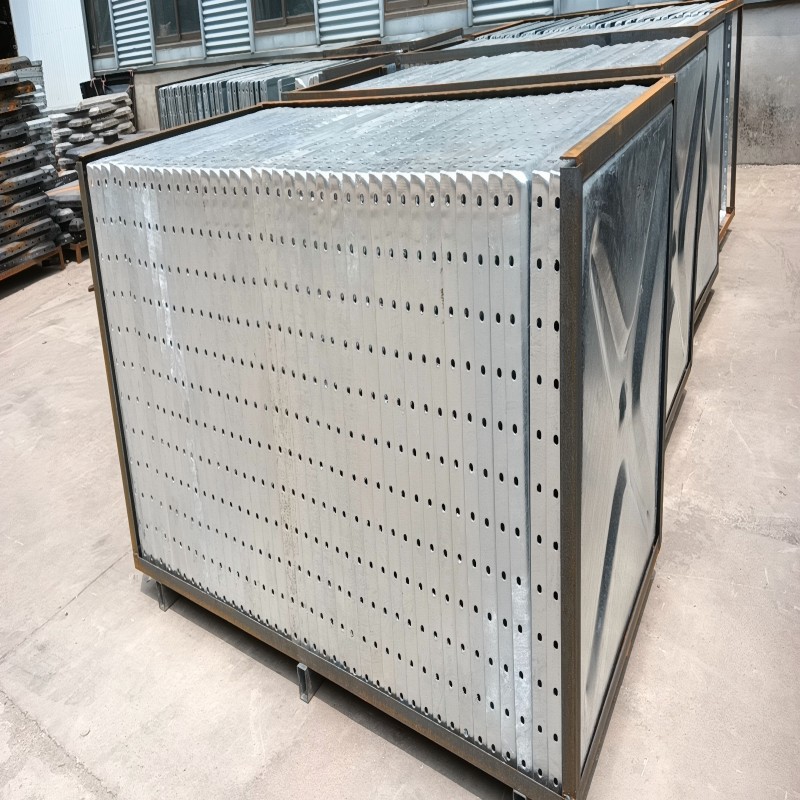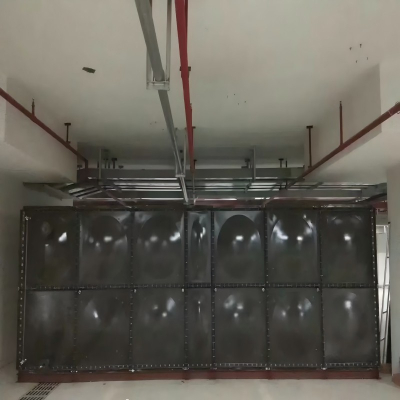Key Characteristics of Hot-dip Galvanized Water Tanks
Hot-dip galvanized water tanks exhibit significant advantages in industrial and civil water supply fields due to their unique processes and structural designs. Their core characteristics are as follows:
1. Exceptional Corrosion Resistance
The hot-dip galvanization process immerses steel into high-temperature zinc liquid, forming a dense zinc-iron alloy coating (usually ≥85μm thick). This coating effectively isolates the substrate from direct contact with water, air, and acid/alkali substances. The zinc layer provides electrochemical protection: since zinc has a higher electrochemical activity than iron, it oxidizes preferentially, sacrificing itself to protect the steel substrate. Even if the surface is slightly scratched, the surrounding zinc layer automatically forms a protective film to repair the damage, significantly extending the tank’s service life. This makes it ideal for humid, high-salt, or corrosive environments (e.g., coastal areas, chemical plants).
2. High Strength and Structural Stability
- Superior Base Material Strength: Made from high-quality carbon structural steel such as Q235B, with a yield strength ≥235MPa and tensile strength ≥375MPa. It can withstand water static pressure and external impacts without easy deformation.
3. Excellent Sealing and Water Quality Assurance
- Multi-layer Sealing Design: Uses aging-resistant sealing materials like butyl rubber and EPDM at panel joints, combined with embedded or bolted fastening structures to eliminate leaks. Interfaces such as manhole covers and drain valves are waterproofed, with sealing lifespans matching the tank itself.
- Water Safety: The galvanized layer is chemically stable, non-reactive with drinking water, and has a smooth surface that resists scaling and reduces microbial growth. Some products meet hygiene certifications (e.g., water contact safety permits), complying with drinking water storage standards.
4. Long Service Life and Low Maintenance Cost
The galvanized layer offers a service life of 15–30 years (far exceeding the 5–8-year lifespan of ordinary steel tanks), requiring no frequent anti-corrosion treatments. Routine maintenance only involves periodic internal flushing (smooth surfaces reduce scale accumulation by over 50%) and sealing component inspections, significantly lowering labor and maintenance costs.
5. Aesthetic Appeal and Environmental Adaptability
The silvery-white galvanized surface is smooth and glossy, with natural zinc crystal patterns that provide both industrial texture and decorative appeal, blending seamlessly into municipal, residential, and garden environments. The galvanized layer is highly weather-resistant, resisting discoloration and powdering under long-term UV and rain exposure, maintaining a clean appearance.
6. Flexible Installation and Customization
Modular design supports on-site assembly, allowing customization of shapes (square, round, etc.) and sizes (height, capacity) to fit spatial constraints. Installation requires no heavy equipment, with bolted or welded connections suitable for various scenarios, making it ideal for retrofitting old and new buildings, as well as outdoor/indoor environments.
7. High-temperature Resistance and Extreme Condition Tolerance
The galvanized layer has a melting point of ~419℃, capable of withstanding long-term flushing at 60–80℃ (special processes can tolerate over 100℃), suitable for hot water storage and industrial circulating water systems. Galvanization also enhances steel toughness, ensuring structural stability at -40℃ to prevent brittle fracture.

Extended Application Scenarios
These characteristics make hot-dip galvanized water tanks widely used in:
- Civil Fields: Residential water supply, fire protection tanks, solar thermal storage;
- Industrial Fields: Cooling water circulation, chemical liquid storage (with medium corrosion assessment), wastewater treatment storage;
- Municipal Engineering: Urban water pressure boosting, drought emergency storage, rainwater harvesting systems.
Conclusion
Hot-dip galvanized water tanks balance durability, functionality, and economy through dual advantages of "material protection + structural optimization," making them an ideal choice for scenarios requiring high standards for water quality, service life, and environmental adaptability. Their core value lies not only in technical parameters but also in detailed designs (e.g., sealing structures, surface treatment, installation convenience) that deeply address user needs, providing a "low-maintenance, long-life, worry-free" water storage solution.






